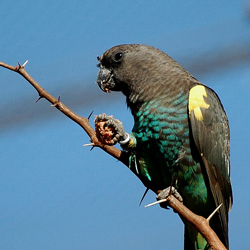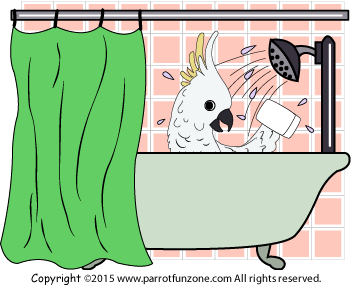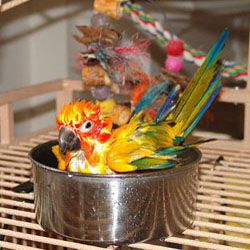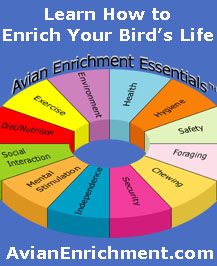Good Hygiene
|
Good hygiene, as it relates to our birds, encompasses two primary areas:
Cleaning In the wild, birds are not "required" to live in close proximity to their droppings. They have a continual supply of fresh unspoiled food to choose from as well as access to fresh water when they need it. In our homes, our birds depend on us to make sure these needs are met. Maintaining a clean environment helps to prevent the spread of disease which can spread very easily via contaminated drinking water, droppings and feather dust. Probably most of us wish we could just tell our birds to "CLEAN YOUR ROOM!" Unfortunately, it is up to us to not only clean their "personal space" but, also to scrub the food stuck on the walls, the poop off of the floor, the seed hulls stuck in the floor boards, the feathers in the heating vents....you get the picture. Keeping up with the mess is a seemingly never ending chore. Fortunately, there are many bird-safe or natural alternative cleaning products available that, when combined with a routine cleaning schedule, will make this thankless job much more manageable. For helpful tips on cleaning, check out our related article,Cleaning Tips Pest Control Insects and other pests can spread disease to humans and animals through their droppings and saliva. Ants, fruit flies, fleas, mosquitos, moths, flies and other creepy crawlers are also a major nuisance. Employing bird-safe pest control measures helps to prevent the spread of disease. Because most commercial pest control products also present hazards to our bird's health it is important to research natural, bird-safe remedies to deal with any pests that may be present in your home. Bathing
In the wild, parrots have many opportunities to bathe in the tropical rains or various bodies of water. In our homes, we need to provide ample opportunities for our birds to bathe. This will not only help keep them clean but it will also promote good health and keep them in beautiful feather. Birds often have preferences on how they like to bathe. Here are some ways that your bird might like to bathe at home:
If your bird appears reluctant to bathe using one method then don't give up, just offer up a different bathing option. For more tips on bathing, check out our related article, Bathing Tips. Check out these videos of birds using different methods of bathing:
Beaks and Nails In the wild, a parrot's beak and nails are maintained naturally in the course of chewing, nut cracking, nest building, climbing, tearing apart fruits and vegetables, landing and walking on rough branches, and swiping beaks frequently on hard, rough surfaces. All this “parrot work” assists in manicuring their beaks and nails. Domestic parrots don't have as varied an environment or activity level. Therefore, some level of human intervention is required to achieve what is accomplished naturally by their wild counterparts. You can help your bird keep their beak and nails trim by:
|
Related Articles
 Why Does My Bird Lose Feathers?
Why Does My Bird Lose Feathers?
 Bathing Tips
Bathing Tips
 Cleaning Tips
Cleaning Tips



































































 Hygiene, by definition, is the practice of cleanliness that prevents the spread of disease and ensures the preservation of health. In captivity, our birds depend on us to ensure their needs are met when it comes to good hygiene.
Hygiene, by definition, is the practice of cleanliness that prevents the spread of disease and ensures the preservation of health. In captivity, our birds depend on us to ensure their needs are met when it comes to good hygiene.  Parrots spend several hours a day preening and grooming their feathers. Systematically their beaks travel from feather to feather removing dirt and putting everything back in place. During this process they often fluff and shake to get rid of dust, dirt and loose feathers.
Parrots spend several hours a day preening and grooming their feathers. Systematically their beaks travel from feather to feather removing dirt and putting everything back in place. During this process they often fluff and shake to get rid of dust, dirt and loose feathers.


